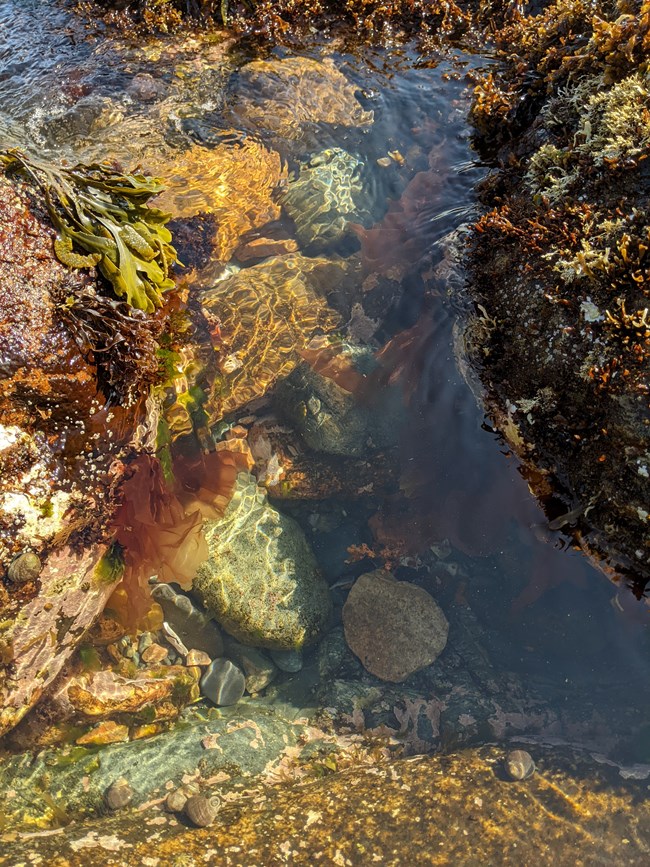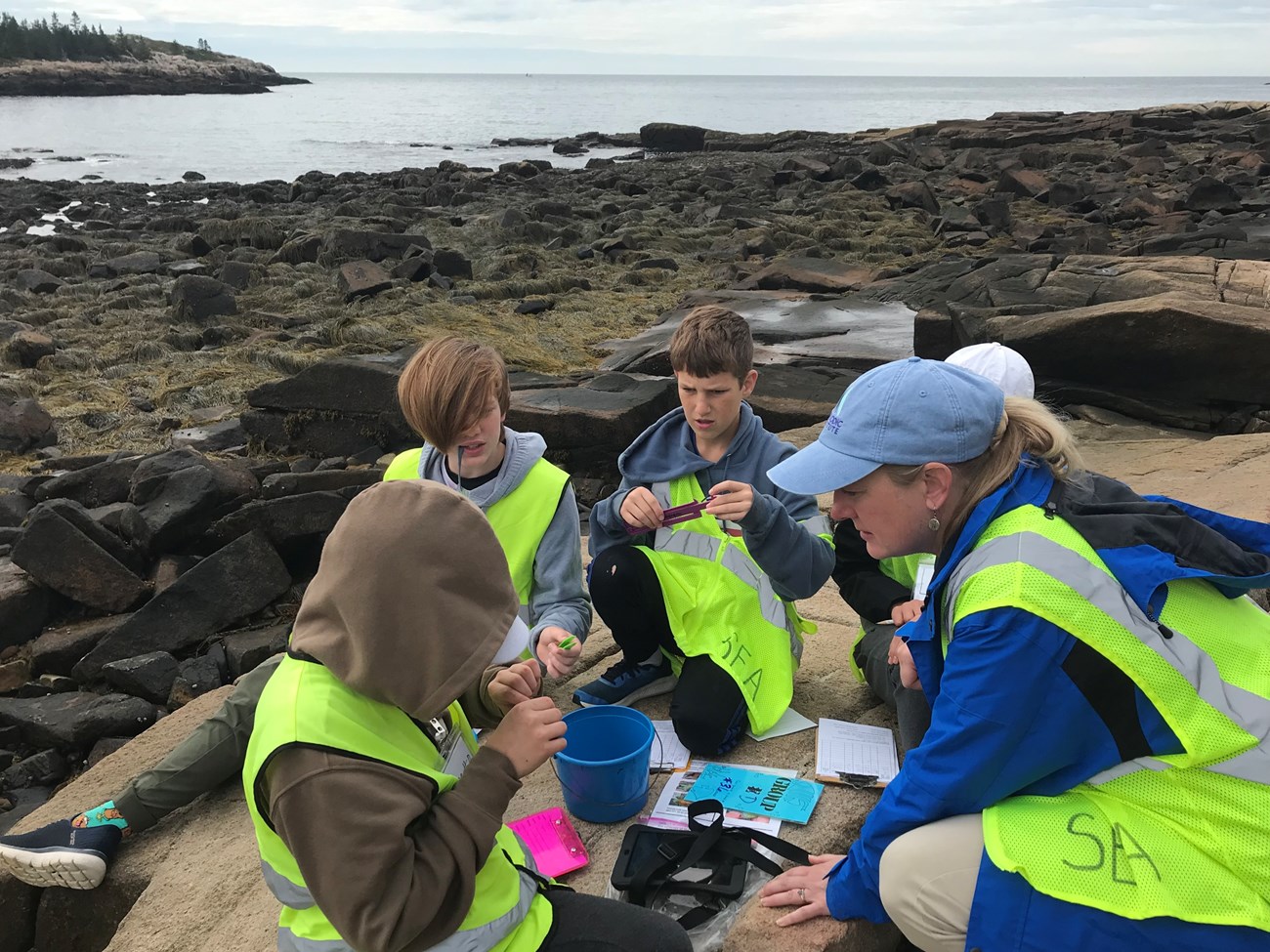Last updated: August 15, 2024
Article
Middle-School Citizen Scientists Track Invasive Crabs at Acadia National Park

Tim Watkins
Ah, the serene soundscape of Acadia National Park’s Schoodic Peninsula! Yellow-rumped warblers and northern parulas twitter from the trees. Shrubs rustle in the wind. Waves swell and crash on rocky shores.
During the school year a curious sound joins this symphony. Exclamations of “Whoa, there are so many!” “Oh my goodness, it’s beautiful!” and “Yes! I got it!” emanate from a very special species: the yellow-vested middle schooler.
During the school year a curious sound joins this symphony. Exclamations of “Whoa, there are so many!” “Oh my goodness, it’s beautiful!” and “Yes! I got it!” emanate from a very special species: the yellow-vested middle schooler.

NPS/Alexa Pezzano
In this case, middle schoolers are collecting data for the Gulf of Maine Research Institute’s (GMRI’s) intertidal crab surveys. In this stretch of Maine, the intertidal zone supports thousands of commercial and recreational fishers and is critical to coastal ecosystem health. Many marine species, from algae to clams and sea stars, call the intertidal zone home.
Invasive European green crabs (Carcinus maenas) and Asian shore crabs (Hemigrapsus sanguineus) are now present in intertidal habitats across the Gulf of Maine, causing great economic and environmental disruption. GMRI’s crab surveys engage young citizen scientists to monitor how the state’s invasive and native crab populations are changing over time.
An Ecological and Economic Threat

Schoodic Institute/Suzannah Buzzell
Green crabs are fast, aggressive predators that pose a significant threat to Maine’s most valuable fisheries by feasting on soft-shelled clams and competing for food with lobsters. They also burrow, loosen sediments, and snip vegetation, degrading habitats like eelgrass beds and salt marshes, which provide food and shelter for a diverse community of wildlife.
“Green crabs are what we struggle with most in terms of shellfish management, because they are so ubiquitous,” explained Heidi Leighton, a coastal biologist with the Maine Department of Marine Resources. “They are an opportunistic invasive that can live in all different kinds of habitats and eat all different kinds of food.”
To make matters worse, a second genetic variety of the European green crab was introduced to Canadian ports from northern Europe in the 1980s. This northern strain, which can tolerate colder temperatures, has traveled down the coast to Maine and started interbreeding with the southern variety. The resulting hybrids are even more adaptable and tolerant of wider temperature ranges along the coast.

Tim Watkins
When an invasive species is so widespread, resilient, and hard to manage, it’s especially important to track changes in the ecosystem and to predict where invasive populations may be most abundant and impactful in the future. This information can allow parks to adjust the management and restoration of salt marshes, eelgrass beds, clam flats, and other intertidal areas. GMRI’s intertidal crab surveys address this need for long-term monitoring and data while getting students excited about marine science.
Adventures in the Intertidal Zone
At low tide on a foggy Wednesday morning in June, I joined the SEA program’s intertidal crab surveys. Seventh graders and their teachers from Community Roots Charter School in Brooklyn, New York, had just arrived at Schoodic Institute for three days of hands-on learning, eager to explore an environment so unlike the urban landscape they were accustomed to. “Pretend you’re walking on a narrow subway platform and the train’s approaching,” chaperones told students to keep them in single-file lines while navigating campus.Before guiding the seventh graders to the cove, SEA educators provided an overview of fundamental concepts including invasive species, citizen science, and tidepool safety. They also distributed scientific tools that students would use in the field, such as calipers (instruments for measuring crab width) and quadrats (PVC-pipe frames that mark a square meter to survey, which a few playful students initially tried to use as hula hoops).
In the intertidal zone, the young citizen scientists carefully crossed a field of seaweed with the texture and slipperiness of wet spaghetti to access their survey sites. A long measuring tape stretched across the cove to mark where they would make their observations. Some were antsy to get started, while others were more timid.

NPS/Alexa Pezzano
Her apprehension quickly turned into excitement when it came time to place quadrats and start the search. Her confidence grew as she watched a classmate fearlessly sift through seaweed, pluck a tiny crab from the rock’s surface, and place it in a nearby bucket. It didn’t take long for her to join in, giggling in pursuit of the elusive crustaceans.
“Getting out into a place where they’re a little bit uncomfortable offers so many opportunities for them to try new things, push their limits, and connect what they’re experiencing here to what we’ve done in the classroom,” said Megan Janke, a science teacher at Community Roots Charter School.
Observations That Make an Impact
After 10 minutes of surveying the quadrats, students documented the species, sex, and size of each crab in their buckets and photographed the largest representative of each species. The crabs ranged from the size of a pencil-top eraser at just a few millimeters to the width of a popsicle stick at roughly 10 centimeters across.Unsurprisingly, European green crabs were the most common catch. Despite the species’ name, color is not a green crab’s most identifiable feature. The top of the shell may be mottled brown or green with small yellow patches, and the bottom may be orange or red during molting. Instead of relying on color, students identified green crabs by the presence of five spines on either side of their eyes.
The students also encountered Asian shore crabs. This species was first identified on the East Coast of the United States in 1988. In the years that followed, it has made its way as far north as Schoodic Point and as far south as North Carolina. The invasive crab, distinguished by three spines on either side of its eyes and light-and-dark banding on its legs, continues to spread northward along the Maine coast. Asian shore crabs are not nearly as pervasive as green crabs, but their growing population is cause for concern. Much like green crabs, Asian shore crabs threaten native marine species through predation and competition for food.
In 2019, a middle-school student in the SEA program was among the first to document an Asian shore crab in Acadia National Park. The student was exploring the intertidal zone when they found a molted Asian shore crab shell. Observations of the invasive species in Acadia have only become more frequent since this initial discovery.
“Students in the SEA program made a very valuable — although terrifying — discovery,” reflected Alexa Pezzano, an Acadia National Park educator and director of the SEA program. “They are participating in a legitimate science project, and it’s incredible to know that what they are doing actually matters and is making an impact.”
Before heading back to the classroom to upload their findings to GMRI’s database, the seventh graders from Community Roots Charter School returned the crabs from their buckets to the intertidal. Their role is to collect data, not to manage the invasive crab population.
Inspiring the Next Generation

Heidi Leighton
Crab surveys expand the knowledge and technical skills of middle-school students in the SEA program by teaching them to collect reliable data on natural resources and the environment with scientific tools. Most importantly, the outdoor adventure facilitates connections with Acadia National Park on emotional and scientific levels; fosters a sense of environmental and cultural stewardship; and shows students that they can make meaningful contributions to scientific research at any age, regardless of their background.
“What’s a beach that we can go to in New York?” two Community Roots Charter School students asked a SEA educator after surveying the intertidal. “We want to keep doing this.”
“It’s important to teach kids that science is really accessible,” explained Lauren Knierim, Schoodic Institute’s Cathy and Jim Gero Acadia Early-Career Fellow in Environmental Science Education. “There are a lot of different barriers to getting into science, but if they start early and learn ‘I can do this in middle school,’ then they are more likely to get involved in environmental science growing up and into their careers.”
The SEA program supports students in stepping out of their comfort zone. Many arrive wide-eyed and wary of unfamiliar landscapes and intimidating scientific protocols. But after three days of studying Acadia’s forests and coastlines, the yellow-vested middle schoolers transform into confident and capable citizen scientists, a new generation of science-literate community members.
Written by Nina Foster, a 2024 Scientists in Parks intern at Acadia National Park. Nina is exploring her professional interests in writing about people, places, science, and history.
